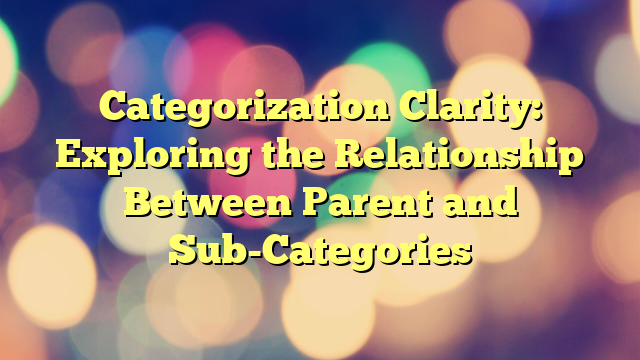Navigating the Layers: Understanding Parent and Sub-Categories

When it comes to organizing and structuring content on a website, the use of parent and sub-categories plays a crucial role. These categories help create a logical hierarchy that enhances user experience and facilitates easy navigation. In this article, we will delve into the concept of parent and sub-categories, exploring their importance and providing practical guidance on how to effectively implement them.
The Significance of Parent and Sub-Categories
Parent and sub-categories act as an organizational framework for content, ensuring that information is well-structured and easily accessible. They allow website visitors to navigate through various levels of content hierarchy, enabling them to find the most relevant information quickly and efficiently. By implementing parent and sub-categories, websites can enhance usability, improve search engine optimization (SEO), and ultimately deliver a better user experience.
When users visit a website, they often have specific information in mind. Parent and sub-categories provide a clear and organized structure that enables them to navigate directly to the relevant content. Without these categories, users would have to sift through a vast amount of information, making it difficult to find what they are looking for. By implementing parent and sub-categories, websites can streamline the user experience and ensure that visitors can easily locate the content they need.
Moreover, organizing content into parent and sub-categories also has a significant impact on search engine optimization. Search engines rely on website structure to understand the context and relevance of each page. By categorizing content into logical groups, websites can provide search engines with clear signals about the topics covered. This, in turn, helps search engines index and rank the pages more accurately, leading to improved visibility in search engine results.
In summary, parent and sub-categories are essential for organizing and structuring content on a website. They enhance user experience by providing a logical hierarchy that enables users to find information quickly. Additionally, they contribute to better search engine optimization, ultimately improving the visibility and discoverability of a website’s content.
Implementing Parent Categories
Parent categories form the top level of a content hierarchy and provide a broad overview of the topics covered on a website. They are typically displayed prominently in the main navigation menu, allowing users to easily identify the main sections of the website. When implementing parent categories, consider the following guidelines:
- Choose Clear and Descriptive Names: Select names that accurately describe the content covered within each category. Avoid generic terms and instead opt for specific and meaningful keywords that users would likely search for.
When choosing names for parent categories, it is crucial to be clear and descriptive. Use keywords that accurately represent the content within each category. Instead of using generic terms, opt for specific and meaningful keywords that users are likely to search for. For example, instead of using a parent category named “Products,” consider using “Electronics” or “Home Appliances” to provide a clearer indication of the content covered.
- Limit the Number of Parent Categories: Ensure that the number of parent categories is manageable and doesn’t overwhelm users. Having too many options can confuse visitors and hinder their ability to navigate effectively. Aim for a concise and easily navigable structure.
While it is important to provide a comprehensive coverage of topics, it is equally important to avoid overwhelming users with too many parent categories. Limit the number of parent categories to a manageable amount, ensuring that users can easily navigate through them without feeling overwhelmed. A concise and easily navigable structure will facilitate a seamless user experience.
- Maintain Consistency: Maintain a consistent naming convention across all parent categories to provide a seamless user experience. This consistency helps users understand the organization of the website and find the information they need more easily.
Consistency in naming conventions is crucial for a seamless user experience. It helps users understand the organization of the website and find information more easily. Ensure that all parent categories follow the same naming convention, making it intuitive for users to navigate through the website. Consistency also contributes to better search engine optimization, as it helps search engines understand the structure and context of the website.
Understanding Sub-Categories
Sub-categories are nested within parent categories and allow for a more granular organization of content. They provide additional levels of hierarchy, enabling websites to further refine their content structure. Here are some considerations when implementing sub-categories:
- Group Related Content: Sub-categories should group together content that shares a common theme or topic. This helps users locate specific information within a broader parent category.
When implementing sub-categories, it is essential to group related content together. Sub-categories should focus on a specific theme or topic within a broader parent category. This organization helps users locate specific information more efficiently and enables them to navigate directly to the content they are interested in.
For example, if the parent category is “Technology,” relevant sub-categories could include “Smartphones,” “Laptops,” and “Gadgets.” By grouping related content under these sub-categories, users interested in smartphones can easily find the relevant information without having to search through the entire “Technology” category.
- Avoid Overlapping Sub-Categories: Ensure that sub-categories are distinct and do not overlap in terms of content. Each sub-category should cover a unique aspect within its parent category, preventing confusion among users.
To maintain clarity and avoid confusion, it is important to ensure that sub-categories do not overlap in terms of content. Each sub-category should cover a unique aspect within its parent category. This distinction allows users to navigate directly to the specific information they need without encountering redundant or repetitive content.
For example, if the parent category is “Recipes,” sub-categories could include “Vegetarian Recipes,” “Dessert Recipes,” and “Quick and Easy Recipes.” Each sub-category focuses on a specific aspect of recipes, providing users with a clear and distinct path to the information they are looking for.
- Consider User Expectations: Analyze how users might navigate your website and anticipate their expectations. Structure sub-categories in a way that aligns with users’ mental models, making it intuitive for them to find the desired information.
When implementing sub-categories, it is important to consider user expectations and align the structure with their mental models. Analyze how users might navigate your website and anticipate their needs and preferences. By structuring sub-categories in a way that aligns with users’ expectations, you can create an intuitive navigation system that allows users to find the desired information effortlessly.
For example, if you have an e-commerce website selling clothing, consider structuring sub-categories based on user preferences such as “Men’s Clothing,” “Women’s Clothing,” and “Kids’ Clothing.” This structure aligns with users’ expectations and makes it intuitive for them to find the clothing category they are interested in.
Best Practices for Parent and Sub-Categories Implementation
To optimize the usage of parent and sub-categories on your website, consider the following best practices:
- Perform Thorough Keyword Research: Before creating parent and sub-categories, conduct keyword research to identify the most relevant and commonly searched terms related to your content. This research will help you choose appropriate names and structure your categories effectively.
Thorough keyword research is essential before creating parent and sub-categories. It helps identify the most relevant and commonly searched terms related to your content. By conducting keyword research, you can choose appropriate names for your categories and structure them effectively, ensuring that they align with user search queries.
- Utilize Logical Hierarchy: Arrange your parent and sub-categories in a logical hierarchy that reflects the relationships between different topics. This hierarchy should make sense to users, allowing them to navigate effortlessly through your content.
When arranging parent and sub-categories, it is important to utilize a logical hierarchy that reflects the relationships between different topics. The hierarchy should make sense to users and enable them to navigate effortlessly through your content. Consider the relationships between topics and organize the categories accordingly, ensuring a seamless user experience.
- Optimize for SEO: Incorporate relevant keywords in your parent and sub-category names, meta tags, and URL structures. This optimization will improve your website’s visibility in search engine results and attract more organic traffic.
To improve the visibility of your website in search engine results, it is important to optimize your parent and sub-category names, meta tags, and URL structures with relevant keywords. By incorporating keywords, you can enhance the search engine optimization of your website, attracting more organic traffic and increasing its visibility.
- Regularly Review and Update: As your website evolves, periodically review your category structure to ensure it remains aligned with your content. Remove outdated or redundant categories, and consider adding new ones to accommodate emerging topics.
As your website evolves and content changes, it is crucial to regularly review and update your category structure. Remove outdated or redundant categories that no longer align with your content, and consider adding new categories to accommodate emerging topics. By keeping your category structure up to date, you can ensure that your website remains organized and easily accessible to users.
Conclusion
Navigating the layers of parent and sub-categories is a fundamental aspect of organizing content on a website. By implementing a well-structured hierarchy, websites can provide an intuitive navigation system, improve user experience, and enhance SEO. Remember to choose clear and descriptive names, group related content, and maintain consistency throughout your categories. By following these guidelines and best practices, you can effectively implement parent and sub-categories, ensuring that your website’s content is easily accessible and organized for your users.

